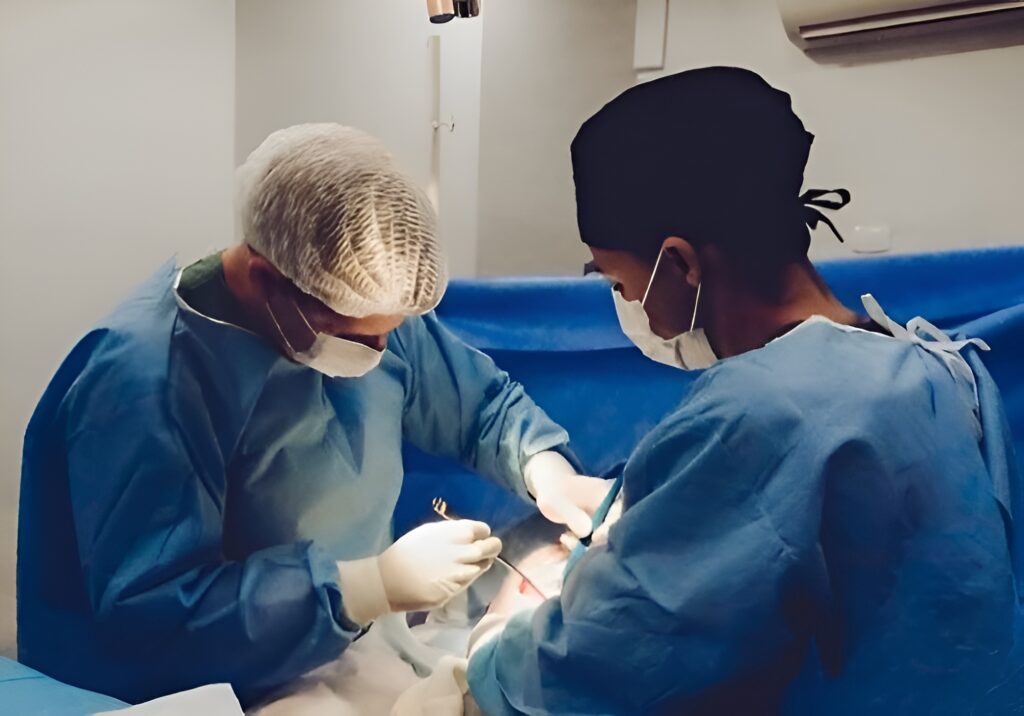
A tummy tuck is a surgical procedure designed to enhance the appearance of the abdomen by eliminating excess skin and fat while tightening the underlying muscles. This procedure is particularly popular among individuals who have undergone significant weight loss or pregnancy, as it can help achieve a flatter and more toned stomach area.
Abdominoplasty serves as the medical term for a tummy tuck. It involves creating an incision along the lower abdomen, typically from hip bone to hip bone, to access and remove excess skin and fat. The remaining skin is then meticulously tightened before being sutured back together.
Table of Contents
Important Things to Know
- This procedure isn’t about shedding pounds. Instead, it sculpts the abdomen by eliminating extra skin and small fat deposits.
- Men are also eligible candidates, not just women.
- Various tucks cater to different levels of excess skin and fat.
- Ideal candidates for this procedure have successfully reached their goal weight but are dealing with loose skin or weakened abdominal muscles. It is important to note that this treatment should not be seen as a replacement for healthy habits and weight loss efforts.
- Healing after this surgery requires patience and strict adherence to the post-op guidelines given by your surgeon.
Who is an Ideal Candidate
With years of experience in weight loss counseling and body contouring, I specialize in tailoring solutions to fit each individual. Prior to undergoing an abdominoplasty, it is crucial to assess if you are the ideal candidate for this cosmetic procedure.

Qualifications of an ideal candidate:
- If diet and exercise aren’t tightening your stubborn belly skin, consider a tummy tuck for a sleeker silhouette.
- A tummy tuck not only removes excess skin but also targets those pesky fat pockets resistant to traditional weight loss methods.
- Ensure optimal health before surgery by maintaining a stable weight and addressing any medical conditions that could impact anesthesia or recovery.
- Quit smoking weeks before surgery to enhance healing and minimize risks during the procedure.
Health considerations and contraindications:
Certain health factors such as obesity or chronic conditions like diabetes may impact your eligibility for this treatment. However, bariatric surgery could be a more effective option for those concerned about weight.
Weight Loss & Nutrition Directory
If you are planning to become pregnant soon, it is advisable to wait until after family planning to avoid potential complications. Inform your surgeon of any history of keloid or hypertrophic scarring that could affect healing and results. Remember to disclose all relevant health information during your consultation to ensure the best possible outcome.
Shelly Rael
Registered Dietitian Nutritionist (RDN)
About — Eat Live Be Well Nutrition (shelleyrael.com)
University of New Mexico
(31) Shelley A. Rael, MS RDN LD | LinkedIn
Real World Nutrition | Facebook
Shelley A. Rael, MS RDN – Registered Dietitian Nutritionist – YouTube
The Procedure
On the day of your cosmetic surgery procedure, you will be given anesthesia for comfort. Your surgeon will make an incision along your abdominal area from hip bone to hip bone or longer if needed. They will then tighten weakened muscles with sutures and may remove excess fat through liposuction.
Day-of-surgery arrangements
- Transportation: Arrange for someone reliable to drive you home post-surgery since you won’t be able to drive due to anesthesia effects.
- Support system: Have someone available at home who can assist you during the initial days of recovery.
- Comfortable attire: Wear loose-fitting clothing that’s easy to put on and remove on the day of surgery.
- Personal items: Bring necessary documents like identification and insurance information.
Post-Operative Recovery
Follow your surgeon’s post-op instructions closely for optimal healing and results. You may feel discomfort, but pain medication will help. Take at least two weeks off work to heal properly. Avoid heavy lifting or intense exercise until cleared by your surgeon. Wearing a compression garment can reduce swelling and aid healing.
Regular check-ups with your surgeon are vital for tracking progress and addressing any concerns during recovery.
Which One is Right for You?
Full Tuck
- The most commonly performed procedure in tummy tucks.
- Involves an incision from hip to hip along the lower abdomen.
- Excess skin and fat are removed by the surgeon, abdominal muscles may be tightened if needed, and the belly button is repositioned.
- Provides comprehensive results by addressing both upper and lower abdominal regions.
Mini Tuck
- Ideal for individuals with minimal excess skin or fat below the navel.
- Requires a smaller incision compared to a full tummy tuck.
- Focuses on removing excess tissue in the lower abdomen only.
- Does not involve repositioning the belly button or tightening muscles above the navel.
Extended Tuck
- Recommended for patients with significant loose skin around their waistline or love handles.
- Addresses concerns in both front and back areas of your abdomen as well as includes liposuction contouring around your hips.
Consultation with an experienced plastic surgeon is key in determining which type of surgery suits you best based on factors such as body shape, overall health, and desired outcomes. Everyone’s situation is unique; what works for one person may not necessarily work for another individual seeking similar treatment options.
Common risks you should know about:
- Infection
Although rare, there is a slight risk of infection post-surgery. Your surgeon will prescribe antibiotics to minimize this risk.
- Bleeding
Some bleeding may occur during or after the procedure, but your surgeon will take the necessary steps to control it and prevent excessive blood loss.
- Scarring
Incisions made during a tummy tuck result in scars. While efforts are made to place them strategically for minimal visibility, individual healing patterns can vary.
- Numbness or changes in sensation
Temporary numbness or changes in sensation around the surgical area are common. These usually resolve over time but can persist in some cases.
Remember, when performed by a skilled plastic surgeon with expertise in abdominoplasty procedures, the risks associated with a tummy tuck are minimal. By diligently following pre-operative and post-operative instructions, you can significantly reduce the chances of encountering complications.
Importance of discussing risks with your surgeon:
Having an open discussion with your surgeon about potential risks associated with a tummy tuck cannot be emphasized enough. Your health status, medical history, and lifestyle factors will be evaluated to determine any increased risk for specific complications. Guidance on minimizing these risks will also be provided.
When done by expert professionals in certified facilities, risks are minimal. Opting for a board-certified plastic surgeon who specializes in tummy tucks lowers the chance of complications.
Post-Surgery:
Following the procedure, certain lifestyle modifications are necessary during recovery. Your surgeon will provide personalized instructions based on your needs. Initially, expect some discomfort or pain post-surgery which can be managed with prescribed medications. Avoid strenuous activities or heavy lifting for several weeks after surgery to ensure proper healing of incisions. Maintaining good posture during this period is crucial for optimal outcomes. A nutrient-rich diet aids healing and promotes overall well-being.
Sustaining Results Long-Term:
While a tummy tuck delivers lasting results by permanently removing excess fat cells from treated areas, maintaining an active lifestyle post-surgery is vital. Regular exercise helps tone abdominal muscles while preventing weight gain. Maintain stable weight levels as significant fluctuations can impact surgical outcomes. A balanced diet coupled with hydration plays a key role in preserving your new physique.

Choosing the Right Surgeon
Selecting the perfect surgeon for your abdominal surgery is crucial to ensure a successful outcome. Here are some crucial factors to keep in mind when choosing a surgeon for your tummy tuck:
Certification and Expertise
Opt for a board-certified plastic surgeon with specific proficiency in performing abdominal surgeries like tummy tucks. Board certification guarantees that the surgeon has undergone rigorous training and meets stringent safety standards. Seek out surgeons with extensive experience in successfully conducting abdominoplasty procedures.
Reputation and Testimonials
Thoroughly research potential surgeons’ reputations before making your decision. Delve into reviews from past patients to gain insight into their experiences with different surgeons. Pay attention to any negative feedback or warning signs indicating inadequate performance or patient dissatisfaction.
Consultation Process
Arrange consultations with multiple surgeons to discuss your objectives, concerns, and expectations regarding the procedure. Use these meetings as an opportunity to inquire about their approach, techniques utilized, anticipated outcomes, as well as any potential risks or complications associated with the surgery.
Visual Evidence
Request before-and-after photos showcasing previous patients who have undergone similar procedures under each surgeon’s care that you are considering. This will allow you to evaluate their aesthetic style and determine if their results align with your vision for yourself.
Communication Dynamics
Establishing good communication between you and your surgeon is pivotal throughout this journey since open dialogue nurtures trust and understanding between both parties involved in achieving desired results.
Remember that selecting a qualified surgeon extends beyond technical expertise; it also involves feeling at ease discussing personal matters related to body image concerns openly.
By thoughtfully weighing these considerations, you can ensure that you choose a surgeon who not only possesses exceptional skills but also comprehends your individual needs and aspirations effectively – greatly enhancing the likelihood of attaining desirable outcomes from your abdominal surgery procedure.
Making the Final Decision
Before deciding on a tummy tuck, consider factors such as realistic expectations, health assessment, emotional preparedness, surgeon selection, and costs. Openly discuss these factors with your surgeon to make an informed decision that aligns with your goals.
Remember, a tummy tuck can enhance your body contour and boost your confidence. By following the guidance of a skilled surgeon and taking proper care during the recovery process, you can achieve the desired results and embark on a new chapter of self-confidence and satisfaction.
source https://herweightloss.com/basics-of-a-tummy-tuck/
 (@shelrael) on Instagram
(@shelrael) on Instagram
No comments:
Post a Comment